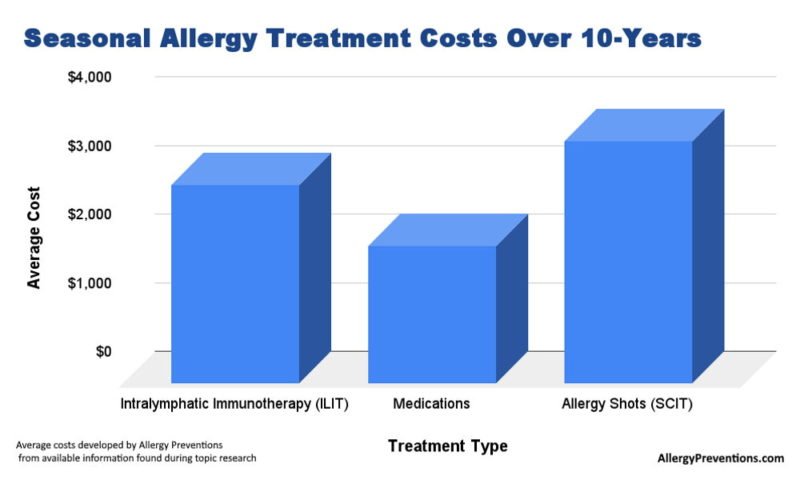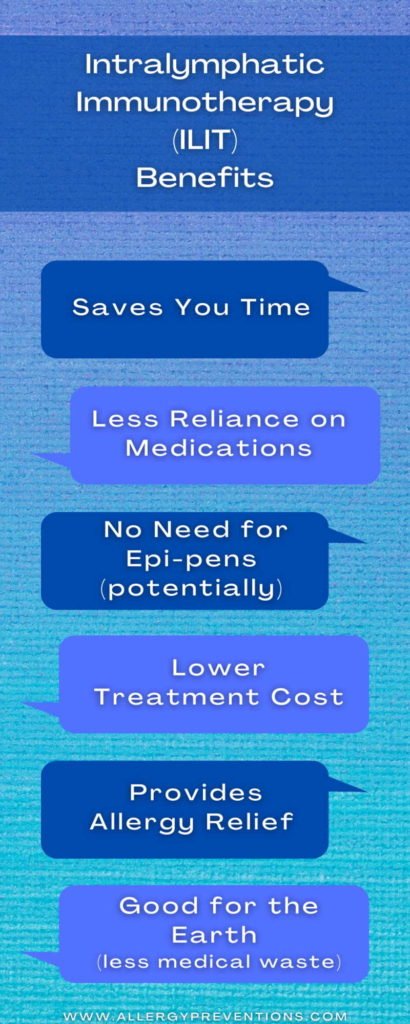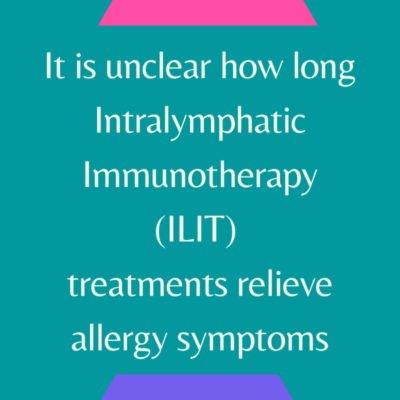Allergies are to blame for over 50 million Americans experiencing itchy eyes, hives, sneezing, runny noses, and a bunch more symptoms each year. Intralymphatic immunotherapy (ILIT) is new to the allergy prevention game, but is it the new allergy treatment of the future?

Table of Contents
What is Intralympthatic Immunotherapy?
Intralymphatic immunotherapy (ILIT) is a type of immunotherapy used in the treatment of allergies. Unlike traditional allergy shots (subcutaneous immunotherapy), which are injected under the skin, ILIT involves injecting allergens directly into the lymph nodes. This method is designed to enhance the effectiveness of immunotherapy by targeting the immune system more directly.
The goal is to desensitize your immune response to allergens and give you symptom relief.
Does ILIT Hurt?
ILIT requires an injection into your groin lymph nodes. It has got to hurt, right?
Surprisingly all the feedback I can find on this treatment option reveals that the procedure does not hurt, or is comparable to a blood draw at its worst.
How Does Intralymphatic Immunotherapy Work?
ILIT is a form of allergen-specific immunotherapy (AIT). Similar to other subcutaneous immunotherapy (SCIT) also known as allergy shots.
ILIT contains small amounts of what you are allergic to, intending to lessen your allergy-related symptoms and immune response.
Some studies have shown that this process requires fewer visits than allergy shots, with faster results.
Fewer visits to the doctor could mean less money out of your pocket and faster allergy relief.
ILIT Treatment Length
Colombia Allergy explains that allergen-specific ILIT treatment consists of 3 injections that are given over three months (4 weeks apart).
This treatment schedule is much faster than getting allergy shots or SCIT.
Allergy shots can be once or twice a week for 6-12 months, followed by 3 to 5 years of maintenance shots once a month.
This treatment option achieves results much faster than allergy shots.
Who Can Get ILIT Treatments?
Intralymphatic immunotherapy is an allergen-specific immunotherapy (AIT) treatment (typically) reserved for individuals who have allergy symptoms that are not under control with medications or are unable to take medications to relieve allergy symptoms.
The Cost of Intralymphatic Immunotherapy 
The cost range that I was able to secure for ILIT treatment was $2500-$3300. This cost does not include the cost of the initial allergy testing.
ILIT might sound expensive, but the price might not be that bad once you break it down.
Allergy Medications Cost
Since the ILIT effective duration still is unknown, I will use a 10-year timeline. Over-the-counter medications vary in price, I used the current price of Claritin on Amazon. You can buy 40 Claritin pills for $22, which is just over a one-month supply. 10-years’ worth of Claritin equals 91 boxes, wow!
The total bill for 10 years of Claritin as your allergy medication is roughly $2002. Adding on any other medications like nasal sprays will further drive this cost higher.
Traditional allergy shots (SCIT) Cost
Shots once a week for the first year range from $20-$100 per shot, if you get 52 shots in the first year that is at least $1040 and can cost as much as $5200, yikes!
This averages out to $3120 annually.
Also, you will need to add on your maintenance shots which are usually once a month, ranging from $10-25, for an average annual cost of $210.
The total cost over 3 years (1 year of weekly and 2 years of maintenance) comes out to $3540.
Overall, the ILIT treatment cost is comparable to allergy shots and taking allergy medications daily.
These comparisons are based on current prices without the use of insurance. Your insurance company may pay for some or all of these costs.
Benefits of ILIT Treatments

There are some potential benefits of using ILIT treatment if it is successful for you. Here is my compiled list:
Time Savings
ILIT Treatments can save you time. When compared to allergy shots, ILIT is a much faster process.
Once you have completed your series, you are good to go. ILIT takes about 3-months, and allergy shots can take three or more years.
Less Need for Medications
The goal of ILIT is to lessen or stop your reactions to your allergens.
If your symptoms stop because of ILIT, your doctor may stop your medications.
If your provider does not want you to stop taking allergy medications, you may need them less often.
No need for an epi-pen (potentially)
Imagine if your allergies cleared up so much that you weren’t anaphylactic, that would save lots of money on Epi-pens and give you peace of mind knowing you no longer need to carry around Epi-pens.
Lower Long-Term Costs
Yes, there is a potential for a pretty steep cost over the first few months of ILIT, but after that, you should see overall savings in treatment costs as well as medication costs.
Allergy Relief
The ultimate goal is allergy relief, and this treatment may give you that relief.
Less Waste (medical, time, landfill)
By not getting allergy shots week after week for years, you are saving resources like needles, vials, and as previously mentioned…your time!
Side Effects & Risks Associated with Intralymphatic Immunotherapy
All potential side effects and risks associated with ILIT are still unknown. Here is what we do know.:
- Swelling at the injection site, around the face, and/or lips
- Hives (urticaria)
- Pain
- Itchiness
- Redness
ILIT Clinical Trials

Intralympatic Immunotherapy clinical trials have been performed on humans and animals a handful of times, but I am finding mixed results when reviewing the documentation from these trials.
ILIT Human Trials
Here are the highlights of the best-documented studies conducted on us humans. You can see more information on these studies at ncbi.nlm.nih.gov
PNAS (Proceedings of the National Academy of Sciences) Clinical Trial (2008)
- Patients experienced less pain (almost none) with the ILIT compared to a blood draw
- ILIT injections had fewer adverse reactions compared to traditional injections
- ILIT did have six mild allergic reactions, including hives and swelling around the face and lips
- The patients with traditional injections during this study experienced mild (18 patients) and severe reactions
- Intralymphatic immunotherapy patients had lower allergy sensitivities within 4-months of treatment
- ILIT lasting effects were comparable to the SIT group after 3-years
Randomized Control Trial (2013)
- Patients with allergic rhinitis received three intralymphatic injections or a placebo
- No severe adverse reactions reported
- Improvement in nasal allergic symptoms with decreased nasal inflammation
Double-blind placebo-controlled Trial (2016)
- 36 patients with pollen-induced rhinoconjunctivitis received ILIT
- No moderate or severe reactions
- Patients reported a significant improvement in seasonal allergic symptoms
- This study concluded that “ILIT is a safe and effective treatment for pollen-induced rhinoconjunctivitis…”
ILIT Plasmablasts and Tolerance Study (2016)
- 7 patients with rhinoconjunctivitis to grass allergens treated with ILIT
- Showed a trend toward symptom improvements
- Significantly raised nasal allergen challenge threshold, and skin prick testing (a good thing)
- Mild side effects were reported from 3 of the 21 total injections
ILIT Pilot Study on Dust Mites, Cats, and Dog Allergies (2017)
- 13 patients treated with ILIT
- ILIT procedure pain was reported as comparable to venous puncture (blood draw)
- 7 patients complained of mild local or systemic reactions
- 4 patients experienced large local reactions or moderate-to-severe systemic reaction
- Even with their severe reactions, the patients wanted to continue treatment
- Nasal symptoms from dust mites were reduced initially, but 1 year later the decrease was not significant
- IgG serum levels (cats and dogs) were compared against the baseline 1 year later
- The IgG levels did not have significant changes after ILIT
ILIT Treatments in Adolescents and Young Adults (2018-2020)
- 17 patients with seasonal allergic rhinitis participated in active treatments
- Patients received 3 injections with 4-5 week intervals
- 2/17 patients experienced serious adverse events
- 13/17 patients experienced other adverse events (pain, swelling, redness, itchiness)
Overall, it seems that the clinical trials did have promising results, and most of these trials ended with an improvement in allergy symptoms. On the other hand, some patients did experience moderate or severe reactions.
ILIT Animal Trials
There have not been many studies conducted with ILIT on animals. I was able to find a few studies which I have summarized.
ILIT Injections in Mice
In 2008, mice were injected directly into a lymph node with bee venom and cat fur allergens (are mice allergic to cats?!) to compare. The injections consisted of 3 shots every 2-weeks. Other mice were injected with the same allergens but with subcutaneous allergen-specific immunotherapy (SCIT) like an allergy shot.
Their study showed that the lymph node injection was more efficient in delivering the antigen versus the SCIT injection.
The study concluded that the ILIT injection induced 10x higher antibodies ( IgG2a) with 100x lower allergen doses compared to the allergy shots.
Horse Trials
12 horses were studied to reduce insect bite hypersensitivity (IBH), which causes allergic dermatitis from midge bites. these horses received three vaccinations of the allergens. 6 horses were injected via ILIT and 6 injected intradermally (SCIT).
The study concluded that the ILIT injection was a little more efficient than the SCIT injection, but not significant.
Additionally, the study showed no adverse effects in the horses from either vaccination route.
Final study results: the study did not determine if the vaccinations worked in preventing IBH because the horses were exported before the study was concluded.
Dog Study
20 dogs received lymph node injections every 4 weeks in the range of 3 to 7 treatments. 12 of the dogs had allergy improvements after 4 weeks.
Unfortunately, there was not a control group to test how efficient the ILIT injections were against atopic dermatitis, so the results cannot be validated.
To conclude the animal studies, the mice study showed the best results with higher antibodies with lower allergen doses. The horse and dog studies showed some improvements and no adverse reactions to ILIT.
Overall, the studies were not complete or well documented.
ILIT Customer Reviews
At the time of writing this article, I cannot find any reviews from actual customers. The only feedback I have received on the ILIT results is from the clinical trials posted as previously mentioned.
Have you received ILIT treatments and want to share your story? Please send me a message through my contact page and let’s coordinate!
Can Intralymphatic Immunotherapy Treat Multiple Allergies?
Yes, ILIT can treat multiple allergies. Since clinical trials are still being conducted treatment is limited to a handful of allergens that cause seasonal allergies
ILIT Treatment Duration

How long do the effects of ILIT last? ILIT is considered a long-term treatment solution, like allergy shots.
Since ILIT is still being studied and the process is fairly new, there isn’t enough information to know how long treatments will last in preventing allergy symptoms.
Where Can You Get Treatments
ILIT is still very new. Unless your allergist has selected you as a good candidate for an ILIT clinical trial, it is difficult to find a location in the United States that performs ILIT services.
The only location that I could find that provides ILIT treatments is Columbia Allergy at their Fremont, CA location.
Final Thoughts
ILIT might be the allergy treatment of the future, but more like the distant future.
There is still much to be learned about ILIT, how it works, side effects, and efficacy, but I believe this is a step in the right direction in developing additional treatment options that may be more affordable to a larger population.
Check this out:
